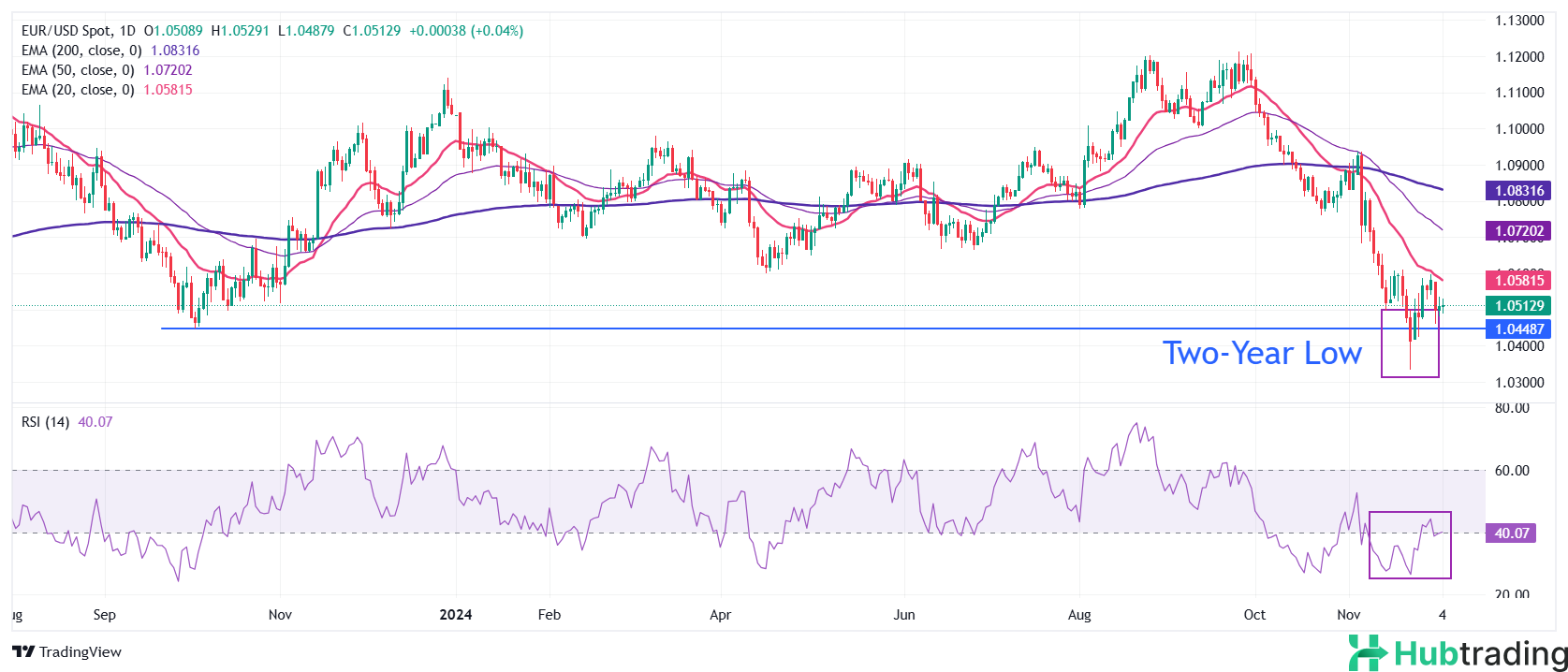- EUR/USD inches up as investors monitor political uncertainty in France ahead of the no-confidence vote against the prime minister.
- ECB’s Holzmann advocates for a 25 bps rate cut at the December 12 policy meeting.
- Market attention will also turn to US private employment and November Services PMI data.
The EUR/USD edged higher on Wednesday, holding above the critical support level of 1.0500 during European trading hours. The currency pair remains in a narrow range as investors await the outcome of a no-confidence vote brought by French far-right and left-wing parties against Prime Minister Michel Barnier. The heightened political uncertainty in France, the Eurozone’s second-largest economy, raises concerns about the potential collapse of the French government, putting additional pressure on the Euro (EUR).
On the economic front, attention shifts to the United States (US) ADP Employment Change and ISM Services Purchasing Managers’ Index (PMI) for November, set to release during the North American session.
Economists anticipate a slowdown in US private-sector job creation, with November’s payrolls projected to increase by 150K, down sharply from October’s 233K. Similarly, the Services PMI, which measures activity in the US services sector, is expected to dip to 55.5 from the previous reading of 56.0, signaling moderating growth.
These data points will play a pivotal role in shaping market expectations for the Federal Reserve's (Fed) monetary policy decision on December 18. According to the CME FedWatch tool, markets currently assign a 74% probability of a 25-basis-point rate cut to a range of 4.25%-4.50% and a 26% chance of rates remaining unchanged.
Investors are also keeping a close eye on the Fed’s Beige Book and a speech by Chair Jerome Powell for further clues on the central bank's rate outlook. Recent comments from Fed officials, including New York Fed President John Williams, indicate support for additional rate cuts as inflation cools. Williams emphasized that future policy adjustments would depend on incoming data but refrained from specifying a target for the Federal Funds Rate.
Ahead of the US employment and services data, the US Dollar (USD) is trading with a muted bias. The US Dollar Index (DXY), which measures the Greenback’s strength against six major currencies, hovers around 106.30.
Despite this, the longer-term outlook for the USD remains positive, partly fueled by geopolitical developments. US President-elect Donald Trump recently threatened to impose 100% tariffs on BRICS nations, citing their efforts to reduce reliance on the US dollar. “The idea that the BRICS countries are trying to move away from the dollar while we stand by and watch is OVER,” Trump declared in a weekend social media post.
As markets navigate through political and economic uncertainties, traders brace for potential volatility across major currency pairs.
Daily Market Movers: EUR/USD Faces Volatility Ahead of French No-Confidence Vote
- The French no-confidence debate is set to commence at 15:00 GMT, with voting expected approximately three hours later. Since Marine Le Pen announced on Monday that her party would support ousting the government, Prime Minister Michel Barnier’s survival now hinges on a shift in position from members of left-wing parties. Failure to secure enough votes could lead to the government’s collapse, intensifying political uncertainty in France.
- EUR/USD edged higher as the US Dollar softened slightly. However, the Euro (EUR) continues to face a subdued outlook as European Central Bank (ECB) officials lean toward further interest rate cuts. Traders widely anticipate another rate reduction in the ECB’s monetary policy meeting on December 12, though the scale of the cut remains uncertain.
- In an interview with Oberoesterreichische Nachrichten, ECB policymaker and Austrian Central Bank Governor Robert Holzmann stated: “As the data currently stands, I think a reduction of 0.25 percentage points is conceivable, not more.”
- Holzmann also flagged inflation risks in the Eurozone, citing potential upward pressure from US tariff policies under President-elect Donald Trump. However, he noted that the impact would largely depend on the specifics of Trump’s policy implementation.
- In contrast, ECB board member Piero Cipollone offered a more dovish view on Tuesday, suggesting that US tariffs could weaken economic activity, leading to lower consumption and reduced inflationary pressures.
- As political and monetary policy uncertainties persist, EUR/USD traders are likely to remain cautious, with the pair poised for potential volatility following the French no-confidence vote and upcoming ECB policy decisions.
Technical Analysis: EUR/USD Consolidates Around 1.0500

EUR/USD remains range-bound near the 1.0500 level during Wednesday’s European session. The overall outlook for the currency pair remains bearish, with all short- to long-term Exponential Moving Averages (EMAs) trending downward, reinforcing the downside bias.
The 14-day Relative Strength Index (RSI) hovers near 40.00, indicating that bearish momentum has eased but the overall downtrend persists.
On the downside, the November 22 low at 1.0330 serves as a critical support level for Euro bulls. Conversely, the 50-day EMA, positioned near 1.0750, acts as a significant resistance level that Euro bulls must overcome to shift the trend upward.





